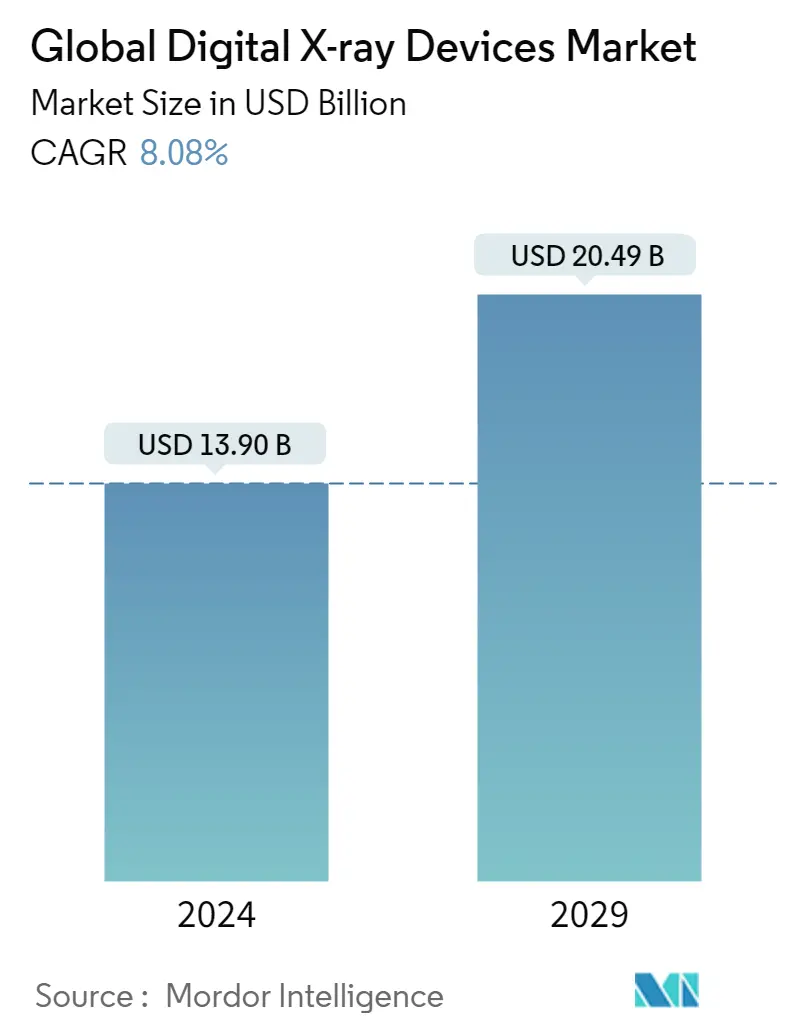Market Size of Global Digital X-ray Devices Industry

| Study Period | 2019 - 2029 |
| Market Size (2024) | USD 13.90 Billion |
| Market Size (2029) | USD 20.49 Billion |
| CAGR (2024 - 2029) | 8.08 % |
| Fastest Growing Market | Asia Pacific |
| Largest Market | North America |
| Market Concentration | High |
Major Players
*Disclaimer: Major Players sorted in no particular order |
Digital X-ray Devices Market Analysis
The Global Digital X-ray Devices Market size is estimated at USD 13.90 billion in 2024, and is expected to reach USD 20.49 billion by 2029, growing at a CAGR of 8.08% during the forecast period (2024-2029).
The COVID-19 pandemic has turned the spotlight on diagnostic imaging, particularly on digital X-ray devices. Digital imaging plays a key role in the diagnosis of COVID-19 and indicates the affected lung tissue in infected patients. Several key market players had focused on innovations in the production of radiography equipment. For instance, in December 2020, Agfa HealthCare launched its new SmartXR for X-ray Artificial Intelligence (AI) for Digital Radiography portfolio to aid during the radiology routine, which has proven important during the COVID-19 crisis. Thus, during the pandemic, the digital X-rays devices market is expected to be positively impacted by COVID-19 accurate diagnosis and treatment.
The studied market growth can largely be attributed to factors, such as the increasing occurrence of orthopedic diseases and cancers, the increasing number of serious injuries, the advantages of digital X-ray systems over conventional X-rays, technological advancements, and product development. Digital X-ray devices use digital x-ray sensors instead of films to capture images. This results in an immediate preview of the images that ultimately improves time efficiency and capacity to digitally transfer images.
The major advantages of digital imaging are cost-effectiveness and easy accessibility. The hospitals can manage the cost-cutting by lowering the film price, reducing the requirement of storage space, and decreasing the number of people required to run the services and archive sections. The images are also instantly available for distribution to the clinical services without the time and physical effort needed to retrieve film packets and reviewing previous imaging on a patient is much easier. This factor majorly impacts the growth of the digital X-ray devices market. Digital X-rays expose approximately 70-80% less radiation than conventional X-rays. This is hugely beneficial for the long-term health of patients, especially pregnant women or patients who are already suffering from illness, thus ensuring safety. With the help of digital X-rays, dentists can now easily recognize oral issues, which is leading to a declining need for an invasive investigation at the diagnosis stage. Additionally, digital radiography safely stores patient X-rays, resulting in no loss from the holders.
Also, due to the increase in the number of dental disorders, cardiac disorders, cancers especially breast cancer, there is an increased demand for digital X-ray devices globally. The American Heart Association (AHA), Heart Disease and Stroke Statistics - 2022 Update data shows that cardiovascular disease (CVD) is listed as the primary underlying cause of death accounting for 19.05 million deaths all over the world in the year 2020. As per the same source, around 7.08 million deaths worldwide were attributed to cerebrovascular diseases in the year 2020. Such a high prevalence of cardiac disease among the population in the country reaped the demand for imaging devices with precise diagnosis and hence Digital X-ray devices acquire their importance in this context.
Additionally, the advancements in technology and increasing product approvals, along with partnerships and collaborations by key players are helping in the market growth. For instance, in February 2022, Carestream Health India has announced the launch of the DRX Compass, an accurate, convenient and configurable digital radiation solution that provides radiologists with a whole new level of efficiency. In addition, DRX Compass provides versatility for configuring desired configurations from a wide range of detectors, tubes, generators, stages and collimators, and how radiation facilities deploy this futuristic digital radiation technology.
Thus, all the aforementioned factors are currently augmenting the growth of the digital X-ray devices market. However, the high installations and device cost, along with the rise in the use of refurbished devices are likely to hinder the market growth.
Digital X-ray Devices Industry Segmentation
As per the scope of this report, digital X-ray or digital radiography is a form of X-ray imaging where digital X-ray sensors are used instead of traditional photographic films. This has an added advantage of time efficiency and the ability to transfer images digitally, as well as enhance them for better visibility. This method bypasses the chemical processing of photographic films. Digital X-ray imaging has high demand, as it requires less radiation exposure compared to traditional X-rays. The Digital X-ray Devices Market is Segmented by Application (Orthopedic, Cancer, Dental, Cardiovascular, and other applications), Technology (Computed Radiography and Direct Radiography), Portability (Fixed Systems, and Portable Systems), End-User (Hospitals, Diagnostic Centers, Other End Users), and Geography (North America, Europe, Asia-Pacific, Middle East & Africa, and South America). The market report also covers the estimated market sizes and trends for 17 different countries across major regions, globally. The report offers the value (in USD million) for the above segments.
| By Application | |
| Orthopedic | |
| Cancer | |
| Dental | |
| Cardiovascular | |
| Other Applications |
| By Technology | |
| Computed Radiography | |
| Direct Radiography |
| By Portability | |
| Fixed Systems | |
| Portable Systems |
| By End User | |
| Hospitals | |
| Diagnostic Centers | |
| Other End Users |
| Geography | ||||||||
| ||||||||
| ||||||||
| ||||||||
| ||||||||
|
Global Digital X-ray Devices Market Size Summary
The digital X-ray devices market is poised for significant growth, driven by the increasing prevalence of orthopedic diseases, cancers, and serious injuries. The shift from conventional to digital X-ray systems offers numerous advantages, including immediate image previews, cost-effectiveness, and reduced radiation exposure, which are particularly beneficial for vulnerable populations such as pregnant women. The COVID-19 pandemic has further accelerated the adoption of digital imaging technologies, as they play a crucial role in diagnosing and monitoring the disease. Technological advancements and product innovations, such as those by Agfa HealthCare and Carestream Health, have enhanced the capabilities of digital X-ray devices, making them more efficient and versatile. The market is also witnessing a surge in demand for portable X-ray systems, which offer the convenience of bedside diagnostics and are essential in emergency situations.
North America, particularly the United States, holds a dominant position in the digital X-ray devices market, fueled by the high incidence of chronic diseases and the adoption of advanced healthcare technologies. The region benefits from a concentration of key players and frequent product launches, such as Canon Medical System's OMNERA 500A and Samsung's GM85 Fit, which have received regulatory approvals. The competitive landscape is characterized by a few major companies, including GE Healthcare, Koninklijke Philips NV, and Siemens Healthineers, who are focusing on technological advancements and strategic alliances to maintain their market positions. Despite the high costs associated with installations and the presence of refurbished devices, the market is expected to grow steadily, supported by ongoing innovations and the increasing need for accurate diagnostic tools.
Global Digital X-ray Devices Market Size - Table of Contents
-
1. MARKET DYNAMICS
-
1.1 Market Overview
-
1.2 Market Drivers
-
1.2.1 Increasing Occurrence of Orthopedic and other Chronic Diseases
-
1.2.2 Advantages of Digital X-ray Systems Over Conventional X-rays
-
1.2.3 Technological Advancements
-
-
1.3 Market Restraints
-
1.3.1 High Initial Cost of Installation and High Device Cost
-
-
1.4 Porter's Five Force Analysis
-
1.4.1 Threat of New Entrants
-
1.4.2 Bargaining Power of Buyers/Consumers
-
1.4.3 Bargaining Power of Suppliers
-
1.4.4 Threat of Substitute Products
-
1.4.5 Intensity of Competitive Rivalry
-
-
-
2. MARKET SEGMENTATION (Market Size by Value - USD million)
-
2.1 By Application
-
2.1.1 Orthopedic
-
2.1.2 Cancer
-
2.1.3 Dental
-
2.1.4 Cardiovascular
-
2.1.5 Other Applications
-
-
2.2 By Technology
-
2.2.1 Computed Radiography
-
2.2.2 Direct Radiography
-
-
2.3 By Portability
-
2.3.1 Fixed Systems
-
2.3.2 Portable Systems
-
-
2.4 By End User
-
2.4.1 Hospitals
-
2.4.2 Diagnostic Centers
-
2.4.3 Other End Users
-
-
2.5 Geography
-
2.5.1 North America
-
2.5.1.1 United States
-
2.5.1.2 Canada
-
2.5.1.3 Mexico
-
-
2.5.2 Europe
-
2.5.2.1 Germany
-
2.5.2.2 United Kingdom
-
2.5.2.3 France
-
2.5.2.4 Italy
-
2.5.2.5 Spain
-
2.5.2.6 Rest of Europe
-
-
2.5.3 Asia-Pacific
-
2.5.3.1 China
-
2.5.3.2 Japan
-
2.5.3.3 India
-
2.5.3.4 Australia
-
2.5.3.5 South Korea
-
2.5.3.6 Rest of Asia-Pacific
-
-
2.5.4 Middle East and Africa
-
2.5.4.1 GCC
-
2.5.4.2 South Africa
-
2.5.4.3 Rest of Middle East and Africa
-
-
2.5.5 South America
-
2.5.5.1 Brazil
-
2.5.5.2 Argentina
-
2.5.5.3 Rest of South America
-
-
-
Global Digital X-ray Devices Market Size FAQs
How big is the Global Digital X-ray Devices Market?
The Global Digital X-ray Devices Market size is expected to reach USD 13.90 billion in 2024 and grow at a CAGR of 8.08% to reach USD 20.49 billion by 2029.
What is the current Global Digital X-ray Devices Market size?
In 2024, the Global Digital X-ray Devices Market size is expected to reach USD 13.90 billion.

